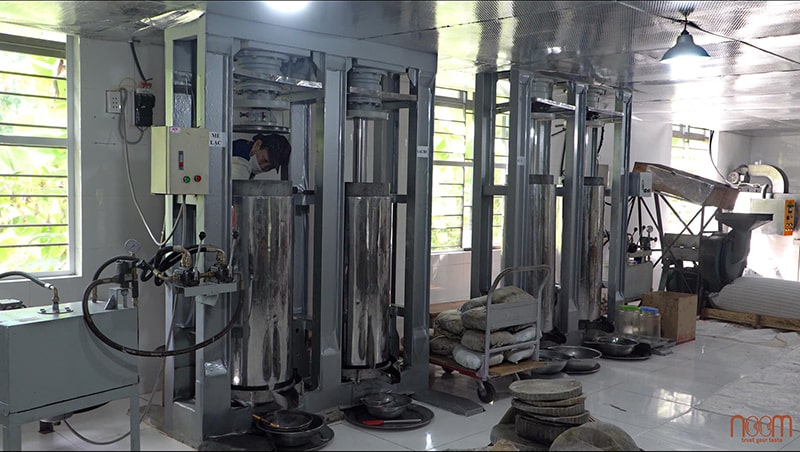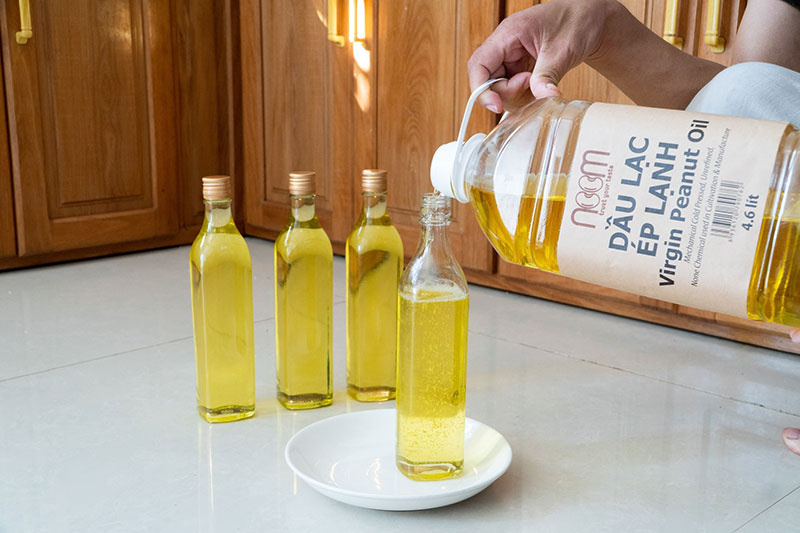How to Press Noom Peanut Oil – Production Process
Danh mục:Blog Knowledge
Non-Refined Cold-Pressed Peanut Oil
The method of pressing peanut oil has been passed down since the 1980s, maintaining the cold-pressing technique without refining, without any heating processes. This preserves the freshness, thickness, pure flavor, and original nutrients from organic eco-friendly peanuts.
Noom Food cold-pressed peanut oil is made from 100% unrefined peanut oil, cold-pressed from carefully selected pure peanut kernels grown in natural organic farms managed and produced by Noom. This product provides essential energy from pure vegetarian fats, helping to prevent and counteract digestive disorders.
Cold-pressing is a mechanical pressing technique. Throughout the process, there is no heating applied at any stage.
Ingredients – Determining Peanut Oil Quality
Before discussing the process of cold-pressing peanut oil, in any type of oil, the selection of varieties and cultivation process determines the quality of the raw material input and simultaneously determines the majority of the quality of the cold-pressed oil output.
If you visit the Xuân Nam village, Đại Thắng commune, to see the organic peanut fields of 163 farming households covering an area of more than 12 hectares, you will witness the joy of farmers when they grow clean peanuts. Instead of using chemical fertilizers, organic fertilizers, they have been using organic materials like manure, leftover cakes, etc. for over 7 years.
The excitement of planting for many years is not only for consumer safety but also for themselves and their families. It’s also a source of pride for the people of Quảng province to rely on cultivating the land and restoring the surrounding ecosystems. You can refer to the organic peanut cultivation process here.
When the sturdy, high-oil content, sweet-tasting peanut kernels are selected, the next step is as simple as how our grandparents used to do it. It’s similar to the renowned olive oil pressing technique in Italy, which has slowly faded away and shifted towards hot-pressed or harmful refined oils on the market. Noom has inherited and continued the mechanical cold-pressing process up to now and is fortunately supported by gourmet women across the country.
5 Stages in the Cold-Pressed Peanut Oil Process
The entire process of cold-pressing peanut oil does not use any food additives or chemicals. At the same time, the equipment is modernized, hygienic, made of stainless steel or solid steel. The process is sanitary and does not come into contact with plastics or any potentially hazardous materials during pressing, and all meet the food safety and hygiene requirements.

Step 1: Peanut kernels are carefully selected, sieved using machines, and finally checked by hand.
Step 2: The peanuts are cleaned and sterilized in the pressing process, with no heating applied at any stage.
Step 3: The peanuts are ground into a paste and wrapped in thick cloth bags that can be reused. They are then placed in a hydraulic press and slowly pressed using mechanical techniques.
Step 4: The oil is naturally filtered slowly five times before being bottled, without any machine or accelerated processes that could break the lipid bonds.
Step 5: Bottling, labeling, and storing in a cool place. Production is done regularly based on orders to ensure that the oil is at its freshest when delivered to customers.
Uses of Cold-Pressed Peanut Oil
Cold-pressed peanut oil is not only safe, following the same mechanism as fruit juice pressing, avoiding 100% artificial agents such as additives and solvents. This traditional premium oil brings great nutrition and flavor to each family’s dishes.
– Provides essential energy from pure vegetarian fats, helping to prevent and counteract digestive disorders.
– Used for frying, sautéing, and cooking various dishes as a substitute for all types of refined cooking oils.
– Used in the preparation of dishes like peanut butter, ice cream, and more.
– Cold-pressed peanut oil is nearly odorless, making it suitable for those who dislike the smell of peanuts.
Home Storage
In the past, grandparents used to bury oil bottles in the ground, in a dark place, tightly sealed to avoid exposure to oxygen. Nowadays, you can pour the oil into small glass bottles for convenient use and storage. Make sure to fill the bottle completely and seal it tightly. Store the oil in a cool, dark place. After opening the bottle, use it within 30 days or store it in the refrigerator to avoid exposure to air inside the bottle.

Unlike the complex process of refining oil, the cold-pressing method of peanut oil is a traditional, environmentally-friendly technique, friendly to both the environment and consumers. The entire process avoids contact with chemicals and preserves the original nutrients found in organic peanuts. We call this “regular cooking oil.” Only when the body consumes non-refined cooking oil can health and taste truly be sustainably enhanced.
If you have any further questions about the cold-pressing process of peanut oil, feel free to share below, and Noom will respond promptly!
 VN
VN